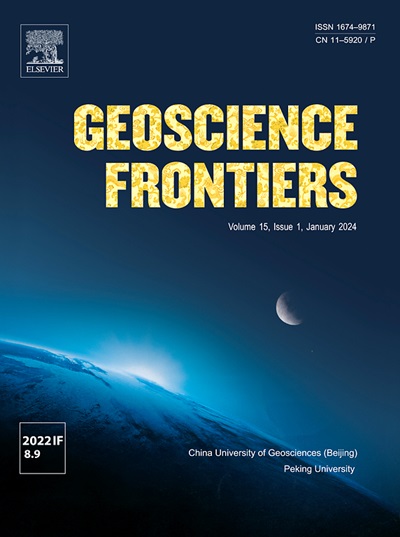东南极洲沿海兰伯特冰川区雪坑微量元素分布及来源评价
IF 8.9
1区 地球科学
Q1 GEOSCIENCES, MULTIDISCIPLINARY
引用次数: 0
摘要
南极雪中微量元素的测量对了解历史大气地球化学变化和环流模式至关重要。然而,对其空间分布的研究仍然有限,特别是那些评估多个雪坑中多种金属的研究,使得解释具有挑战性。研究了东南极洲兰伯特冰川盆地4个雪坑中Cd、Ba、Pb、U、Bi、V、Mn、Fe、Cu、Zn、as等微量元素的分布及其来源。微量元素表现出地点、元素和季节相关的变化,在内陆站点观察到较高的浓度。δ18O和离子浓度随离海岸距离和海拔高度的增加而降低,表明海洋排放的影响。地壳源主要贡献Ba、U、V、Mn和Fe,非地壳源主要贡献Cd、Bi、Zn、Pb、Cu和As。正矩阵分解(PMF)分析表明,2号坑和3号坑的微量元素浓度受到地壳和非地壳源的双重影响,而4号坑则受到混合源的影响。坑1(沿海站点)也表明受高度动态的海洋气候和环境影响的混合源。PMF结果揭示了雪坑间排放源和大气输送模式的相似性,有助于对更长的冰芯记录进行更全面的解释。总的来说,这项研究为微量元素的分布提供了有价值的见解,并增强了我们对过去环境和气候条件的理解。本文章由计算机程序翻译,如有差异,请以英文原文为准。

Assessment of trace elements distribution and sources from snowpits in the Lambert Glacier region, coastal East Antarctica
The measurement of trace elements in Antarctic snow is crucial for understanding historical atmospheric geochemical changes and circulation patterns. However, studies on their spatial distributions remain limited, particularly those evaluating multiple metals across several snowpits, making interpretation challenging. This study investigates the distributions and sources of trace elements—including Cd, Ba, Pb, U, Bi, V, Mn, Fe, Cu, Zn, and As—across four snowpits in the Lambert Glacier Basin, East Antarctica. The trace elements exhibit site-, element-, and season-dependent variations, with higher concentrations observed at inland sites. In contrast, δ18O and ion concentrations decrease with increasing distance from the coast and elevation, underscoring the influence of marine emissions. Crustal sources primarily contributed to Ba, U, V, Mn, and Fe, while non-crustal sources predominantly contributed to Cd, Bi, Zn, Pb, Cu, and As. Positive matrix factorization (PMF) analysis indicates that trace element concentrations in Pits 2 and 3 are influenced by both crustal and non-crustal sources, while Pit 4 reflects a mixed-source influence. Pit 1 (coastal site) also indicates the mixed sources with influence of a highly dynamic marine climate and environment. The PMF results reveal similarities in emission sources and atmospheric transport patterns across the snowpits, facilitating a more comprehensive interpretation of longer ice core records. Overall, this study provides valuable insights into trace element distributions and enhances our understanding of past environmental and climatic conditions.
求助全文
通过发布文献求助,成功后即可免费获取论文全文。
去求助
来源期刊

Geoscience frontiers
Earth and Planetary Sciences-General Earth and Planetary Sciences
CiteScore
17.80
自引率
3.40%
发文量
147
审稿时长
35 days
期刊介绍:
Geoscience Frontiers (GSF) is the Journal of China University of Geosciences (Beijing) and Peking University. It publishes peer-reviewed research articles and reviews in interdisciplinary fields of Earth and Planetary Sciences. GSF covers various research areas including petrology and geochemistry, lithospheric architecture and mantle dynamics, global tectonics, economic geology and fuel exploration, geophysics, stratigraphy and paleontology, environmental and engineering geology, astrogeology, and the nexus of resources-energy-emissions-climate under Sustainable Development Goals. The journal aims to bridge innovative, provocative, and challenging concepts and models in these fields, providing insights on correlations and evolution.
 求助内容:
求助内容: 应助结果提醒方式:
应助结果提醒方式:


